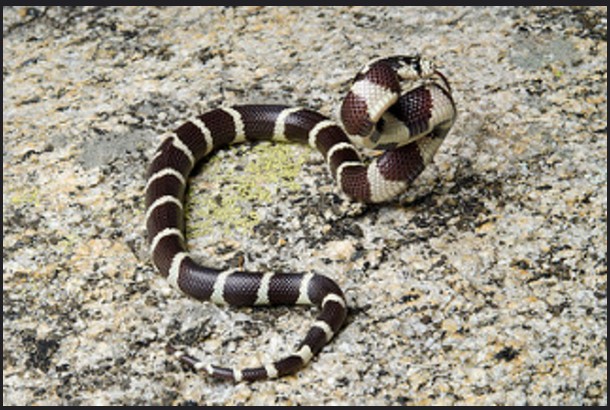Chapters
Navigate to chapter
► Chapter 1: California Kingsnake in Focus
► Chapter 2: California Kingsnake Requirements
► Chapter 3: Purchasing Your California Kingsnake
► Chapter 4: Maintenance for California Kingsnake
► Chapter 5: Nutritional Needs of California Kingsnake
► Chapter 6: California Kingsnake Husbandry
► Chapter 7: Caring Guidelines for California Kingsnake
► Chapter 8: Breeding Your California Kingsnake
► Chapter 9: Keeping Your California Snake Healthy
Chapter Two: California Kingsnake Requirements

In this chapter, you will get a whole lot of information on its pros and cons, its average associated costs as well as the legal licensing you need so that you will be well on your way to becoming a legitimate California Kingsnake pet owner – should you decide to be one! Let’s do this!
First of all, you should ask yourself exactly why you want to keep a California Kingsnake as a pet. California Kingsnake has an average lifespan of 20 years! It’s like raising a child. But if you are only considering getting a California Kingsnake as a status symbol, then you should rethink your choices. As much as California Kingsnake would make a wonderful addition to your household with their natural elegance and exquisiteness, their care would also demand much of your commitment. The responsibilities you would have to carry include feeding them, cleaning after them, seeing to their maintenance, and understanding their behavior.
California Kingsnake can be quite aggressive creatures, and their defense mechanism involves a lot of eating, even their own kind, however California Kingsnake also responds fairly well to human touch especially if it is constant, so you would have to make sure that you do not neglect them. They are not picky eaters but it can definitely eat you alive, so please watch out. You will also have to check them constantly for ticks and mites and their overall health.
Simply put, California Kingsnake requires a fair amount of guarantee that you will be there to take care of them and make sure they are okay. You cannot take care of a California Kingsnake halfway, and you have to be all in – starting with recognizing within yourself if you have what it takes to take care of this lovely and royal creature.
California Kingsnakes can be kept as pets as long as you have a license. Like any other pets, native reptiles are protected by law so if you want to keep one as a pet, you’ll need a license from the Office of Environment and Heritage (National Perks and Wildlife Service)
California Kingsnakes must be bought from licensed dealers or breeders. Licensing is important because it will protect your Kingsnakes species and their ecosystems. It also keeps the reptiles and their owners safe. Also, licensing helps people/pet owners abide by NSW laws.
There are different types of license depending on the number of animals you own and how difficult they are to keep. It is required that you demonstrate your experience and training if you are planning to keep venomous reptiles, like Kingsnakes.
As a reminder there is no federal law governing private possession or ownership of exotic animals in the United States. You need to pay attention not on a national level but on a local level, with your local and state laws and ordinances, to see what is permitted and what is not.
The regulations vary from one city/state to another, as some outright ban or prohibit exotic or dangerous animals, while others simply call for permits that set down requirements such as micro-chipping, an established relationship with a veterinarian, and even insurance. Some may also ask you to present proof that you are acquiring the animal from a recognized breeder and that the snake was bred in captivity (as opposed to being captured from the wild), so acquiring a license from the Office of Environment and Heritage can really help.
It is also a good idea to check the rules about keeping pet snakes based on where you are – city, town, neighborhood, and even in the apartment building, if applicable. All these are reasonable precautions to take simply for the fact that should you ever be found to be keeping such a pet illegally, the discovery could result in consequences such as fines or, worse, the confiscation of your pet. You might not even be able to find a veterinarian willing to give your California Kingsnake medical care if you are found to be keeping it without the correct permits.
Permits may also be necessary for importing, exporting, or traveling with an exotic or a naturally dangerous animal.
You also need to be constantly updated on information regarding your local state laws at least once every six months. Regulations can change, and you don’t want to find yourself suddenly in violation of a law which was amended after you thought you had abided by it a year ago.
If all this seems complicated and really overwhelming, you have to remind yourself that you are bringing a potentially dangerous animal into a human community. One that can definitely eat your neighbor alive! As such, restrictions and limitations should be expected so that the safety of anyone involved will be ensured.
It must also be noted as a point of fact that the illegal trade in exotic animals has been an immensely profitable business for backyard breeders and illegal importers. If you care about these animals at all, you shouldn’t support activities which promote their unlawful capture from the wild or the breeding and transport of these animals in inappropriate and pitiless conditions.
How Many California Kingsnake Should You Keep?
California Kingsnake, being one of the most well-mannered python types, may not be an ideal choice for first-time snake-keepers. They can adapt well with regular human contact but they need an owner who can handle them with care. Their quite aggressive nature is not suitable for families with young children.
Just like when considering other pets, the decision of whether you can keep more than one California Kingsnake or not depends on your overall capacity to commit to all of them. The only risk is that since this snake is quite a dominant type, it might end up eating another breed of snake to show them who is the King. It’s probably better to separate them from one another to avoid competition.
Of course, you must also keep in mind that keeping more than one California Kingsnake means an increase in responsibility financially, timewise, and even mentally.
Efforts of cleanup and cage maintenance will be doubled, or tripled, and can definitely take up all your time. Before committing to it, you should assess your capacity (financially, mentally and timely) to provide what your pets will require without fail. You will have to be completely ready and prepared because you’re about to serve a King!
Taking care of one California Kingsnake is already a lot, especially if this is your first time owning a snake as a pet. Be sure to make an informed and responsible decision on how many California Kingsnake you can responsibly and dutifully care for and keep.
California Kingsnake with Other Pets
The California Kingsnake is a carnivorous natural predator, and when in the wild, they kill their prey by constricting it and swallowing even the most venomous and dangerous snakes (they’re a King remember?). Adult California Kingsnake are also known to feed on adult mice, rats, or young chickens, because of this, California Kingsnake they can pose real threat to your dog, cat, child or even you! If they feel threatened at all, they will kill you.
As stated before, California Kingsnake can be quite aggressive if not handled or trained properly. They can be a recommended snake to have if you are looking for a more challenging pet or if you’re already an expert in taking care of snakes.
Want to read the entire thing?

